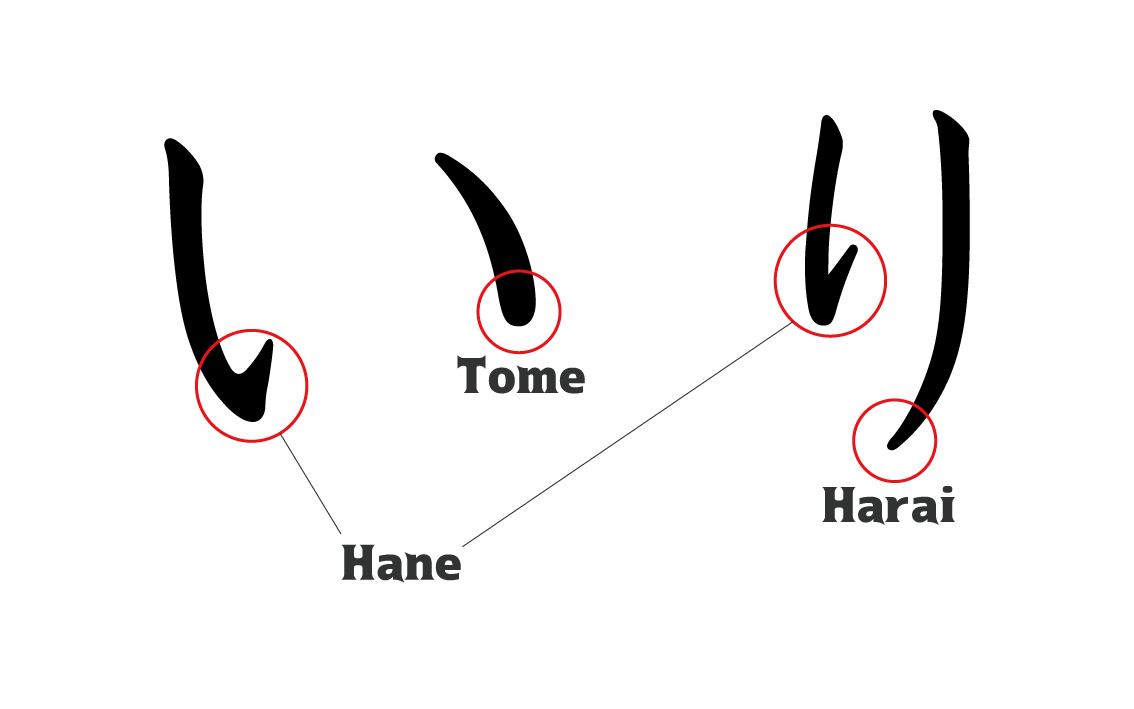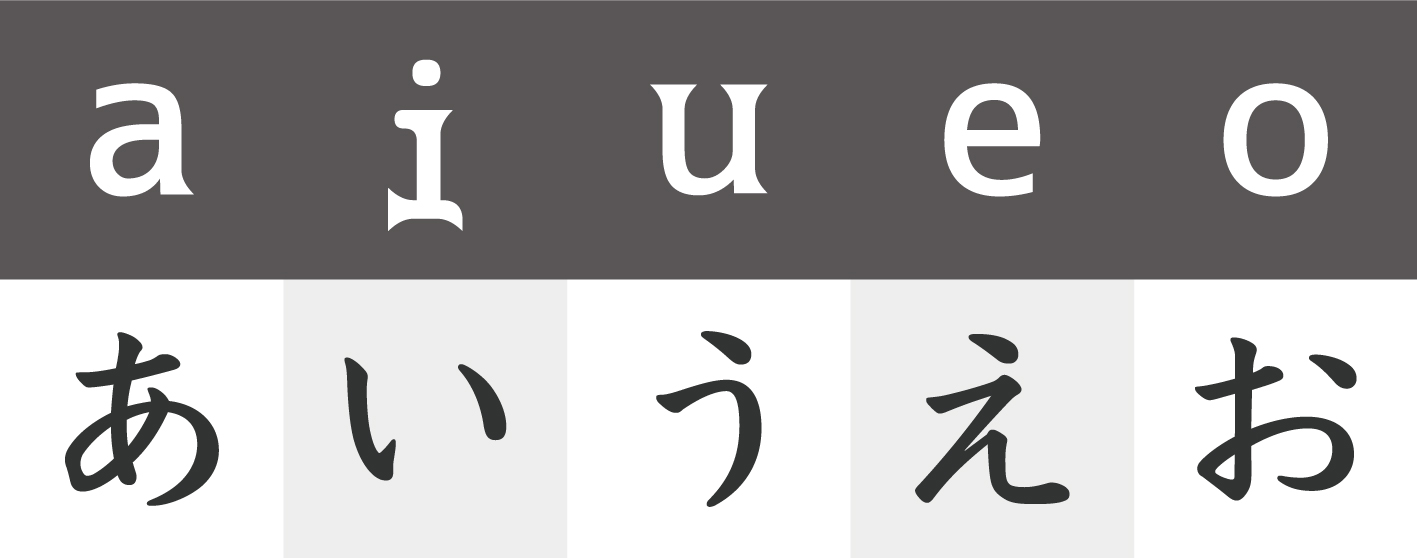

Are You Ready? Let’s Learn ‘A I U E O’!
2018-10-07T22:21:17
The first step to learn the Japanese language is to learn the basic elements – a, i, u, e, o. These characters are the foundation in learning Japanese since they are considered as the vowel sounds. But before we learn how to read and write, let us know the three important ways –tome, hane and harai –on how to end a stroke first when writing the Japanese characters.
Tome, Hane, Harai
In Japanese writing, it is necessary to familiarize yourself with ‘tome’, ‘hane’, and ‘harai’ since they are the three essential components when you end your strokes upon writing the Japanese characters.
All Japanese characters have stroke order. It is necessary to write those characters in correct order to write well in a natural manner. Now, let’s learn how to read and write ‘a, i, u, e, o’ in Hiragana with proper order.
How to read and write ‘あ’
‘あ’ is pronounced as /ɑ/. It can be written in three strokes with different endings. The end of the first and second strokes are ‘tome’, and the final stroke ends in ‘harai’? (see illustration below)
Okay it’s your turn. Practice many times now!
Now Let’s Use ‘あ’!
Practice many times now. Then, let’s learn how to use ‘あ’ in your daily life by learning how to read and write some everyday expressions in Japanese.
ありがとう [a ri ga to u]
When you want to show your appreciation for someone, you can say ‘ありがとう[a ri ga to u]’. It means ‘thank you’. ‘ありがとうございます [a ri ga to u go za i ma su]’ is more polite than ‘ありがとう’.
あいしてる [a i shi te ru]
If you love someone and you want to express your love, you can say ‘あいしてる [a i shi te ru]’ which means ‘I love you’. Another way of expressing your love or your admiration is by saying ‘すき [su ki]’ or ‘だいすき [da i su ki]’.
あつい [a tsu i]
Japanese summer is getting hotter every year. When you visit Japan in summer, you will hear everyone say ‘あつい [a tsu i]’.
あれ/あの [a re / a no]
Both ‘あれ [a re]’ and ‘あの [a no]’ are equal to pronoun ‘that’ in English. Use of ‘あれ/あの’ is illustrated below.
Example:
I like that (あれ).
I like that (あの) pen.
We use ‘あれ’ when you point to something or someone far without explicitly telling the specific thing while ‘あの’ is used when you point to something or someone far with specific mention of the object or noun.
How to read and write ‘い’
‘い’ is pronounced as /ɪ/. It can be written in two strokes. The end of the first stroke is ‘hane’ and second is ‘tome’. (see illustration below)
Let’s use ‘い’ now!
いただきます [i ta da ki ma su]
You should say ‘いただきます [i ta da ki ma su]’ before eating with your hands together like you are praying. In Japanese, it means that you appreciate the food. By the way, you should say ‘ごちそうさま(でした)[go chi so u sa ma (de shi ta)]’ after eating.
いってきます/いってらっしゃい [i tte ki ma su / i tte ra ssya i]
Say ‘いってきます [i tte ki ma su] ’ when you leave people behind, but you are planning to come back. And the people who are left behind should answer ‘いってらっしゃい [i tte ra ssya i]’ .
いらっしゃい(ませ)[i ra ssya i (ma se)]
When you arrive at some places like malls, markets, the front staff would say ‘いらっしゃいませ [i ra ssya i ma se]’ to you. This means “Welcome! ” or “May I help you!” Most Japanese would not say anything, but they either nod, smile, or would not say anything. ‘いらっしゃい [i ra ssya i] ’ is friendly and ‘いらっしゃいませ’ is polite.
How to read and write ‘う’
‘う’ is pronounced as /ʊ/. It can be written in two strokes. The first is ‘tome’, and the second is ‘harai’. (see illustration below)
Let’s use ‘う’ now!
うまい [u ma i]
‘うまい [u ma i]’ has several meanings. It can mean delicious and good.
For example:
The food that you cook is delicious (うまい).
You are a good (うまい) singer.
うれしい [u re shi i]
When you feel happy or glad, you say ‘うれしい [u re shi i]’.
うたう [u ta u]
‘うたう [u ta u]’ (verb) which means sing. And ‘うた [u ta]’ (noun) is song. ‘うた[u ta] を[o] うたう[u ta u]’ means ‘sing a song’.
How to read and write ‘え’
‘え’ is pronounced as /e/. It can be written in two strokes. The first stroke is ‘tome’, and the second is also ‘tome’. (see illustration below)
Let’s use ‘え’ now!
えらい [e ra i]
‘えらい [e ra i]’ can be used in different contexts. ‘えらい’ may mean ‘great’, ‘serious’, and ‘hard’.
Example:
Edison is a great (えらい) man.
I have a serious (えらい) problem.
This task is very hard (えらい).
え? [e?]
Most Japanese people say ‘え?’ when they need to clarify something if they are unable to hear the word that you say. Also, if you are able to hear something that is unbelievable or shocking, you can say ‘え!’
ええと… [e e to…]
If a Japanese is asked about something and is thinking about it or is uncertain or confused on what to say, he or she says ‘ええと…’.
How to read and write ‘お’
‘お’ has no exact equivalent of the English vowel sounds, but has more or less similar pronunciation with /ɔ/. It can be written in three strokes. The first is ‘tome’, and the second is ‘harai’, and the third is ‘tome’. (see illustration below)
Let’s use ‘お’ now!
おはよう(ございます) [o ha yo u (go za i ma su)]
To start your day in the morning, you say ‘おはよう [o ha yo u]’ to the people you see around. ‘おはようございます [o ha yo u go za I ma su]’ is more polite than ‘おはよう’.
おねがいします [o ne ga i shi ma su]
‘おねがいします [o ne ga i shi ma su]’ may mean ‘please’ if you ask someone to do something. It can be used before you start doing something like before starting a presentation, before playing any game or any sport.
おいしい [o i shi i]
When you eat something and you think that the food you are eating is delicious or tasty, you say ‘おいしい [o I shi i]’. It is more polite than ‘うまい’.
おめでとう(ございます) [o me de to u (go za i ma su)]
When Japanese people celebrate some special occasions like birthdays, weddings, new year or other victorious celebrations such as passing an exam, they say ‘おめでとう [o me de to u]’. ’おめでとうございます [o me de to u go za i ma su]’ is more polite than ‘おめでとう’.
おかえり(なさい) [o ka e ri (na sa i)]
‘おかえり [o ka e ri]’ is a reply to someone who comes home who said “ただいま [ta da i ma]”. The people who are at home are usually the ones who usually say “おかえり!”
おだいじに [o da i ji ni]
‘おだいじに [o da I ji ni]’ is usually said to someone who is sick which means ‘get well soon’. The people who usually say ‘おだいじに’ are the friends, family, or the hospital staff like nurses or doctors of the sick person.
おつかれさま(です) [o tsu ka re sa ma (de su)]
‘おつかれさま [o tsu ka re sa ma]’ is normally said to each other during or after the day’s work. People in the same workplace usually tell ‘おつかれさま’ to each other when they meet a colleague in the hallway. ‘おつかれさま’ is also said to a husband or wife who just arrived home from work. ‘おつかれさまです [o tsu ka re sa ma de su]’ is more polite than ‘おつかれさま’.
おやすみ(なさい) [o ya su mi (na sa i)]
At the end of the long day’s work, you are tired and you are now in bed ready to sleep. You suddenly remember someone so you send a message saying ‘おやすみ [o ya su mi]’ which means ‘goodnight’. ‘おやすみなさい [o ya su mi na sa i]’ is more polite than ‘おやすみ’.
Now, you know how to write ‘あいうえお’. Let’s use them in daily life! That’s all for today! おつかれさま!












